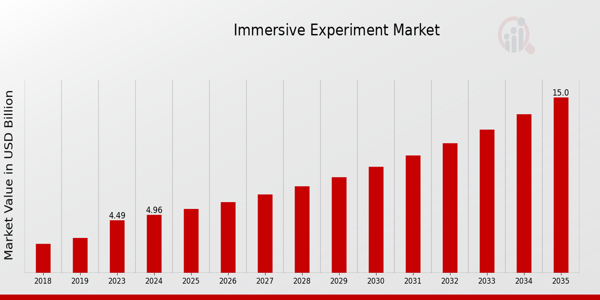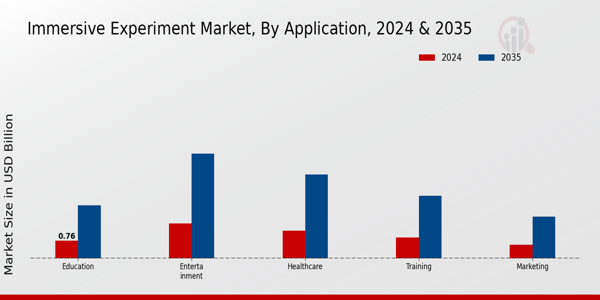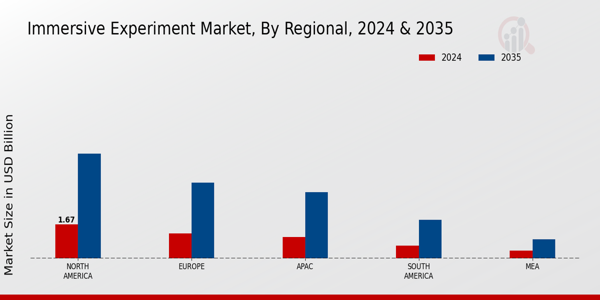Immersive Experiment Market Overview
As per MRFR analysis, the Immersive Experiment Market Size was estimated at 4.49 (USD Billion) in 2023.
The Immersive Experiment Market Industry is expected to grow from 4.96 (USD Billion) in 2024 to 15.0 (USD Billion) by 2035. The Immersive Experiment Market CAGR (growth rate) is expected to be around 10.58% during the forecast period (2025 - 2035).
Key Immersive Experiment Market Trends Highlighted
The global immersive experience market is being driven by advances in technology, particularly in virtual reality (VR) and augmented reality (AR). These technologies are becoming more accessible and affordable, which encourages their widespread adoption across various sectors. Industries such as entertainment, education, and healthcare are leveraging immersive experiences to enhance user engagement and improve learning outcomes. The demand for unique and interactive experiences is fostering innovation and creating a dynamic landscape where businesses must remain agile to keep pace with consumer expectations. Opportunities are ripe for exploration as more companies recognize the potential of immersive experiences.
The potential exists in areas such as retail since customers can engage through virtual try-ons and shopping experiences. Also, there's an increased demand for advanced collaborative tools in remote working as teams need to communicate and brainstorm within a virtual environment. The educational domain offers great potential, too. Immersive learning lets students have firsthand experience of concepts in ways not possible through traditional instruction. More recently, there seems to be an increased emphasis on enabling social and multi-user experiences in virtual immersive spaces. There is much interest in using social media where the users connect in VR and AR environments.The integration of artificial intelligence into immersive experiences is also emerging, offering more personalized and responsive interactions. With an increasing emphasis on storytelling and emotional engagement, brands are exploring new ways to connect with their audiences through compelling narrative-driven experiences. Overall, the global immersive experience market is set to continue evolving, shaped by ongoing technological advancements and changing consumer preferences.

Source: Primary Research, Secondary Research, MRFR Database and Analyst Review
Immersive Experiment Market Drivers
Technological Advancements in Virtual and Augmented Reality
The steady advancements in virtual reality (VR) and augmented reality (AR) technologies are pivotal for the growth of the Immersive Experiment Market Industry. As VR and AR hardware become more sophisticated, the experiences offered become increasingly realistic and engaging. These technological improvements facilitate immersive simulations that are invaluable for training, education, and entertainment sectors. For instance, developments in head-mounted displays (HMDs), motion tracking sensors, and haptic feedback devices contribute to a level of realism that enhances the understanding and retention of information in educational settings.
This allows immersive experiences not only to be more effective but also to span a variety of applications, ranging from gaming to specialized training in fields such as medicine and engineering. Furthermore, the growing adoption of 5G technology is expected to significantly reduce latency and increase data transmission speeds, enabling real-time immersive experiences across multiple platforms, thus driving market expansion. The combination of these factors positions technological advancements as a primary driver in the Immersive Experiment Market.
Surge in Demand for Immersive Learning Experiences
There is a notable increase in demand for immersive learning experiences across educational institutions and corporate training programs. The Immersive Experiment Market Industry is being significantly influenced by the growing recognition of the efficacy of immersive methods in delivering complex knowledge and skills. Immersive experiments allow learners to engage in interactive scenarios, thereby enhancing understanding and retention rates.
This trend is particularly pronounced in e-learning platforms, which are catered increasingly towards interactive and experiential learning modalities.
Expansion of the Gaming Sector
The global gaming industry continues to expand rapidly, feeding into the growth of the Immersive Experiment Market Industry. As gamers seek more realistic and interactive experiences, immersive technologies such as VR and AR play a crucial role. Game developers are investing heavily in immersive experiences to meet consumer demands, thus propelling the market forward. The convergence of gaming with social experiences and other entertainment formats further enhances the potential for growth.
Immersive Experiment Market Segment Insights
Immersive Experiment Market Application Insights
The Immersive Experiment Market is poised for growth, particularly within the Application segment, where various sectors leverage immersive technologies for enhanced experiences. By 2024, the market is projected to be valued at 4.96 USD Billion, expanding to 15.0 USD Billion by 2035, highlighting a robust trajectory in market growth. Within this space, the Education sector stands out with a valuation of 0.76 USD Billion in 2024, anticipated to rise to 2.28 USD Billion in 2035, emphasizing the increasing demand for immersive learning experiences that enhance student engagement and improve educational outcomes.
Similarly, the Entertainment sector dominates the market as it captures significant consumer interest and engagement, projecting a value of 1.5 USD Billion in 2024 and growing to 4.5 USD Billion by 2035. This growth is driven by the consumer preference for immersive video games, virtual reality concerts, and cinematic experiences that provide interactive enjoyment. The Healthcare segment, valued at 1.2 USD Billion in 2024, with projections reaching 3.6 USD Billion in 2035, indicates the growing application of immersive experiments in medical training and therapeutic solutions, where simulations facilitate learning and patient treatment, respectively.
Likewise, the Training sector, valued at 0.9 USD Billion in 2024, is expected to increase to 2.7 USD Billion in 2035. Companies prioritize immersive training programs that enhance employee skills and retention in dynamic work environments, thereby driving this growth. The Marketing sector, while projected to hold a value of 0.6 USD Billion in 2024 and increase to 1.8 USD Billion by 2035, portrays the strategic use of immersive technologies to create engaging brand experiences that capture consumer attention effectively. The various segments of the Immersive Experiment Market display distinct growth trajectories, driven by the increasing adoption of immersive technologies across sectors, shaping the landscape of how experiences are delivered and consumed in both consumer and professional realms.
Growing consumer expectations for interactive and engaging content foster ongoing development within these segments, creating substantial opportunities for market expansion and innovation.

Source: Primary Research, Secondary Research, MRFR Database and Analyst Review
Immersive Experiment Market Technology Insights
The Immersive Experiment Market within the Technology segment is poised for significant growth, with a market valuation of 4.96 billion USD in 2024 and an anticipated increase to 15.0 billion USD by 2035. This growth is driven by the rising adoption of innovative technologies in various sectors, including education, gaming, healthcare, and training. Among its various components, technologies like Virtual Reality (VR), Augmented Reality (AR), and Mixed Reality (MR) hold considerable importance. VR has been pivotal in transforming gaming and entertainment, providing users with fully immersive experiences, while AR enhances real-world environments with digital overlays, making it significant in retail and marketing.
MR combines the strengths of both VR and AR, allowing for interaction with both physical and virtual objects, which is increasingly sought after in training and simulation applications. The dynamics of the Immersive Experiment Market reveal vast opportunities for growth, influenced by technological advancements and evolving consumer preferences, while also facing challenges such as high implementation costs and the need for content creation. The insights from the Immersive Experiment Market industry reflect a favorable outlook for continued innovation and expansion across its varied technological facets.
Immersive Experiment Market End Use Insights
The Immersive Experiment Market showcased notable growth within the End Use segment, reaching a valuation of 4.96 USD Billion in 2024, with expectations of further expansion by 2035. This market has experienced a steady focus on both B2B and B2C channels as they cater to different consumer needs and applications. The B2B sector has seen a growing trend among businesses utilizing immersive technologies for training, marketing, and product demonstrations, which underscores its significance in enhancing operational efficiency and customer engagement.
Conversely, the B2C segment emphasizes entertainment and personal experiences, contributing significantly to market growth by providing interactive and engaging content for consumers. The segmentation reflects robust consumer demand driven by technological advancements and the increasing accessibility of immersive experiences. Challenges such as infrastructure requirements and the need for high-quality content remain, yet opportunities abound as more businesses recognize the value of immersive experiments in enhancing user experiences, further fueling the Immersive Experiment Market revenue.
Moreover, understanding Immersive Experiment Market data is crucial for organizations looking to capitalize on this trend, offering insights into Immersive Experiment Market statistics that highlight shifting consumer behaviors and preferences.
Immersive Experiment Market Content Type Insights
The Immersive Experiment Market is poised for significant growth, with an expected valuation of 4.96 USD Billion in 2024 and reaching 15.0 USD Billion by 2035. This growth trajectory can be attributed to advancements in content type offerings, which play a critical role in the overall market landscape. Within this segment, categories such as Simulation, Interactive Experiences, and Immersive Storytelling stand out, each contributing uniquely to market dynamics. Simulation continues to grow in importance, primarily due to its applications in training and education, where realistic scenarios foster engagement and skill development.
Meanwhile, Interactive Experiences allow users to participate directly, enhancing user engagement, which is vital in entertainment and marketing domains. Immersive Storytelling captures the audience's attention by combining narrative with sensory engagement, creating memorable experiences that foster emotional connections. Altogether, these elements illustrate the diverse strategies employed across the Immersive Experiment Market, shaping the future of interactive content delivery while addressing the varying needs of consumer bases and industry demands.
The interplay of these content types continues to be influenced by technological advancements and changing consumer preferences, which encourage innovation and creativity across the Immersive Experiment Market industry.
Immersive Experiment Market Regional Insights
The Immersive Experiment Market revenue is forecasted to reach 4.96 USD Billion in 2024, driven by heightened interest in engagement-driven technologies across various sectors. In terms of regional segmentation, North America leads with a valuation of 1.673 USD Billion in 2024, indicating a significant appetite for advanced immersive experiences in both enterprise and entertainment applications. Europe follows with a valuation of 1.223 USD Billion, reflecting a competitive landscape as businesses invest in immersive technologies to enhance consumer engagement.
The APAC region is also noteworthy, valued at 1.057 USD Billion in 2024, as technological advancements and growing gaming markets enhance its importance in the Immersive Experiment Market industry. South America, valued at 0.624 USD Billion, shows potential for growth as emerging economies increasingly adopt immersive technologies. The MEA region, while currently at a valuation of 0.383 USD Billion, is gradually gaining traction, and its diverse cultural landscape presents unique opportunities for immersive experiences. Collectively, these regional insights reveal a dynamic global landscape driven by market trends that emphasize user engagement, innovation, and technological advancements, leading to promising growth avenues in the coming years.

Source: Primary Research, Secondary Research, MRFR Database and Analyst Review
Immersive Experiment Market Key Players and Competitive Insights
The Immersive Experiment Market has shown tremendous growth, driven by advancements in technology and an increasing demand for engaging experiences across various sectors, including entertainment, education, and gaming. Companies within this market continually strive to innovate and differentiate their offerings to capture a larger share of the market. By leveraging cutting-edge technologies such as virtual reality (VR) and augmented reality (AR), firms are enhancing user interactions, thereby facilitating immersive and interactive experiences. The competitive landscape is characterized by constant evolution as organizations seek to meet the changing preferences of consumers, who are increasingly drawn to immersive experimental environments. As the competition escalates, key players are not only focusing on technological enhancements but also on strategic partnerships, marketing initiatives, and customer engagement strategies to stay ahead in this dynamic arena.
HTC has firmly established its presence in the Immersive Experiment Market, recognized for its innovation and commitment to delivering high-quality VR experiences. Leveraging its extensive expertise in hardware and software development, HTC offers a line of advanced VR products that cater to both consumers and enterprises. The company's strengths lie in its strong brand reputation, a well-established ecosystem of developers, and a wide array of content that enriches the user experience. Furthermore, HTC's focus on creating immersive experiences that extend beyond entertainment to applications in education, healthcare, and business sets it apart in a crowded marketplace. Its strategic investments in research and development help to ensure that the company remains at the forefront of emerging trends, fostering a robust framework for future innovations in the immersive experiment sector.
Oculus stands as a powerful player in the Immersive Experiment Market, largely renowned for its focus on consumer-grade virtual reality headsets. As a subsidiary of a major technology leader, Oculus benefits from significant resources and expertise that enable it to create highly immersive experiences that connect with users worldwide. The company's strengths include a user-friendly interface and a diverse portfolio of VR content that appeals to various demographics, ensuring broader adoption of its technologies. Oculus is notable for continuously enhancing its product offerings, featuring improved graphics, performance, and affordability, thus attracting a diverse audience to experience immersive content. The alignment of Oculus with gaming, educational tools, and social experiences has further solidified its standing in the market. Its ability to integrate seamlessly with various platforms contributes to an ever-growing user base, enhancing its competitive edge in the expanding landscape of immersive experiences.
Key Companies in the Immersive Experiment Market Include:
- HTC
- Oculus
- Alibaba
- Google
- Samsung
- Viveport
- Apple
- Sony
- Unity Technologies
- Magic Leap
- Meta
- Microsoft
- Immersive VR Education
- NVIDIA
- Epic Games
Immersive Experiment Market Industry Developments
Recent developments in the Immersive Experiment Market have been dynamic, particularly with companies like Meta and Microsoft investing heavily in extended reality (XR) technologies. Meta's advancements with the Meta Quest series continue to redefine user experiences, while Microsoft’s integration of HoloLens in various industries showcases the versatility of immersive technologies. HTC has launched new initiatives aimed at educational applications of virtual reality, enhancing its position in the educational sector. Meanwhile, Unity Technologies remains a critical player with its strong focus on real-time 3D development tools, which are increasingly adopted across various industries. In terms of mergers and acquisitions, both Google and Samsung have been involved in strategic partnerships to enhance their immersive tech capabilities, although no significant acquisitions have been announced in recent months. Growth in market valuation is evident, driven by increasing demand for immersive solutions in entertainment, training, and remote collaboration. Companies like Nvidia and Epic Games are also enhancing their portfolios, further stimulating competition and innovation within the immersive experience landscape. The overall competitive environment is set to grow as advancements in AR and VR continue to attract interest and investment from diverse sectors.
Immersive Experiment Market Segmentation Insights
-
Immersive Experiment Market Application Outlook
- Education
- Entertainment
- Healthcare
- Training
- Marketing
-
Immersive Experiment Market Technology Outlook
- Virtual Reality
- Augmented Reality
- Mixed Reality
-
Immersive Experiment Market End Use Outlook
-
Immersive Experiment Market Content Type Outlook
- Simulation
- Interactive Experiences
- Immersive Storytelling
-
Immersive Experiment Market Regional Outlook
-
North America
-
Europe
-
South America
-
Asia Pacific
-
Middle East and Africa
| Report Attribute/Metric |
Details |
| Market Size 2023 |
4.49 (USD Billion) |
| Market Size 2024 |
4.96 (USD Billion) |
| Market Size 2035 |
15.0 (USD Billion) |
| Compound Annual Growth Rate (CAGR) |
10.58% (2025 - 2035) |
| Report Coverage |
Revenue Forecast, Competitive Landscape, Growth Factors, and Trends |
| Base Year |
2024 |
| Market Forecast Period |
2025 - 2035 |
| Historical Data |
2019 - 2024 |
| Market Forecast Units |
USD Billion |
| Key Companies Profiled |
HTC, Oculus, Alibaba, Google, Samsung, Viveport, Apple, Sony, Unity Technologies, Magic Leap, Meta, Microsoft, Immersive VR Education, NVIDIA, Epic Games |
| Segments Covered |
Application, Technology, End Use, Content Type, Regional |
| Key Market Opportunities |
Augmented reality in education, Virtual reality training simulations, Immersive entertainment experiences, Remote collaboration tools, Behavioral health therapy applications |
| Key Market Dynamics |
Technological advancements, Increased consumer engagement, Growing demand for training, Expanding applications across industries, Rising adoption of VR/AR |
| Countries Covered |
North America, Europe, APAC, South America, MEA |
Frequently Asked Questions (FAQ) :
The Immersive Experiment Market is expected to be valued at 4.96 USD Billion in 2024.
By 2035, the Immersive Experiment Market is projected to reach a valuation of 15.0 USD Billion.
The market is anticipated to grow at a CAGR of 10.58% from 2025 to 2035.
The Entertainment application segment is expected to be valued at 4.5 USD Billion in 2035.
The North America region is anticipated to be valued at 1.673 USD Billion in 2024.
The Healthcare application segment is expected to be valued at 3.6 USD Billion in 2035.
Major players in the market include companies like HTC, Oculus, Google, and Apple.
The Marketing application segment is expected to reach a valuation of 1.8 USD Billion in 2035.
The APAC region is projected to be valued at 3.258 USD Billion in 2035.
The Training application segment is anticipated to be valued at 0.9 USD Billion in 2024.

















